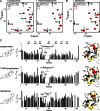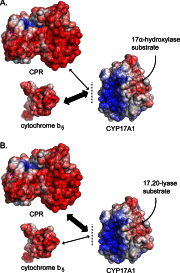Substrate-modulated cytochrome P450 17A1 and cytochrome b5 interactions revealed by NMR
- PMID: 23620596
- PMCID: PMC3675632
- DOI: 10.1074/jbc.M113.468926
Substrate-modulated cytochrome P450 17A1 and cytochrome b5 interactions revealed by NMR
Abstract
The membrane heme protein cytochrome b5 (b5) can enhance, inhibit, or have no effect on cytochrome P450 (P450) catalysis, depending on the specific P450, substrate, and reaction conditions, but the structural basis remains unclear. Here the interactions between the soluble domain of microsomal b5 and the catalytic domain of the bifunctional steroidogenic cytochrome P450 17A1 (CYP17A1) were investigated. CYP17A1 performs both steroid hydroxylation, which is unaffected by b5, and an androgen-forming lyase reaction that is facilitated 10-fold by b5. NMR chemical shift mapping of b5 titrations with CYP17A1 indicates that the interaction occurs in an intermediate exchange regime and identifies charged surface residues involved in the protein/protein interface. The role of these residues is confirmed by disruption of the complex upon mutagenesis of either the anionic b5 residues (Glu-48 or Glu-49) or the corresponding cationic CYP17A1 residues (Arg-347, Arg-358, or Arg-449). Cytochrome b5 binding to CYP17A1 is also mutually exclusive with binding of NADPH-cytochrome P450 reductase. To probe the differential effects of b5 on the two CYP17A1-mediated reactions and, thus, communication between the superficial b5 binding site and the buried CYP17A1 active site, CYP17A1/b5 complex formation was characterized with either hydroxylase or lyase substrates bound to CYP17A1. Significantly, the CYP17A1/b5 interaction is stronger when the hydroxylase substrate pregnenolone is present in the CYP17A1 active site than when the lyase substrate 17α-hydroxypregnenolone is in the active site. These findings form the basis for a clearer understanding of this important interaction by directly measuring the reversible binding of the two proteins, providing evidence of communication between the CYP17A1 active site and the superficial proximal b5 binding site.
Keywords: Cytochrome P450 17A1; Cytochrome b5; Enzyme Mechanisms; NMR; Protein Conformation; Protein-Protein Interactions; Steroidogenesis.
Figures







Similar articles
-
Kinetic processivity of the two-step oxidations of progesterone and pregnenolone to androgens by human cytochrome P450 17A1.J Biol Chem. 2017 Aug 11;292(32):13168-13185. doi: 10.1074/jbc.M117.794917. Epub 2017 Jul 6. J Biol Chem. 2017. PMID: 28684414 Free PMC article.
-
Human cytochrome P450 17A1 conformational selection: modulation by ligand and cytochrome b5.J Biol Chem. 2014 May 16;289(20):14310-20. doi: 10.1074/jbc.M114.560144. Epub 2014 Mar 26. J Biol Chem. 2014. PMID: 24671419 Free PMC article.
-
Cytochrome b5 Activates the 17,20-Lyase Activity of Human Cytochrome P450 17A1 by Increasing the Coupling of NADPH Consumption to Androgen Production.Biochemistry. 2016 Aug 9;55(31):4356-65. doi: 10.1021/acs.biochem.6b00532. Epub 2016 Jul 29. Biochemistry. 2016. PMID: 27426448 Free PMC article.
-
Role of cytochrome b5 in the modulation of the enzymatic activities of cytochrome P450 17α-hydroxylase/17,20-lyase (P450 17A1).J Steroid Biochem Mol Biol. 2017 Jun;170:2-18. doi: 10.1016/j.jsbmb.2016.02.033. Epub 2016 Mar 11. J Steroid Biochem Mol Biol. 2017. PMID: 26976652 Review.
-
A Homodimer Model Can Resolve the Conundrum as to How Cytochrome P450 Oxidoreductase and Cytochrome b5 Compete for the Same Binding Site on Cytochrome P450c17.Curr Protein Pept Sci. 2017;18(5):515-521. doi: 10.2174/1389203717666161220142957. Curr Protein Pept Sci. 2017. PMID: 28000554 Review.
Cited by
-
Steroidogenic cytochrome P450 17A1 structure and function.Mol Cell Endocrinol. 2021 May 15;528:111261. doi: 10.1016/j.mce.2021.111261. Epub 2021 Mar 26. Mol Cell Endocrinol. 2021. PMID: 33781841 Free PMC article. Review.
-
Cytochrome b5 enhances androgen synthesis by rapidly reducing the CYP17A1 oxy-complex in the lyase step.FEBS Lett. 2018 Jul;592(13):2282-2288. doi: 10.1002/1873-3468.13153. Epub 2018 Jun 21. FEBS Lett. 2018. PMID: 29888793 Free PMC article.
-
The cytochrome P450 24A1 interaction with adrenodoxin relies on multiple recognition sites that vary among species.J Biol Chem. 2018 Mar 16;293(11):4167-4179. doi: 10.1074/jbc.RA117.001145. Epub 2018 Jan 25. J Biol Chem. 2018. PMID: 29371396 Free PMC article.
-
Structure-Functional Analysis of Human Cytochrome P450 2C8 Using Directed Evolution.Pharmaceutics. 2021 Sep 9;13(9):1429. doi: 10.3390/pharmaceutics13091429. Pharmaceutics. 2021. PMID: 34575505 Free PMC article.
-
Mechanistic Scrutiny Identifies a Kinetic Role for Cytochrome b5 Regulation of Human Cytochrome P450c17 (CYP17A1, P450 17A1).PLoS One. 2015 Nov 20;10(11):e0141252. doi: 10.1371/journal.pone.0141252. eCollection 2015. PLoS One. 2015. PMID: 26587646 Free PMC article.
References
-
- Ortiz de Montellano P. R. (2005) Cytochrome P450. Structure, Mechanism, and Biochemistry, 3rd ed., pp. 133–134 and 448–450, Kluwer Academic/Plenum Publishers, New York
-
- Schenkman J. B., Jansson I. (2003) The many roles of cytochrome b5. Pharmacol. Ther. 97, 139–152 - PubMed
-
- Zhang H., Im S. C., Waskell L. (2007) Cytochrome b5 increases the rate of product formation by cytochrome P450 2B4 and competes with cytochrome P450 reductase for a binding site on cytochrome P450 2B4. J. Biol. Chem. 282, 29766–29776 - PubMed
-
- Akhtar M. K., Kelly S. L., Kaderbhai M. A. (2005) Cytochrome b(5) modulation of 17α-hydroxylase and 17–20 lyase (CYP17) activities in steroidogenesis. J. Endocrinol. 187, 267–274 - PubMed
Publication types
MeSH terms
Substances
Grants and funding
LinkOut - more resources
Full Text Sources
Other Literature Sources

